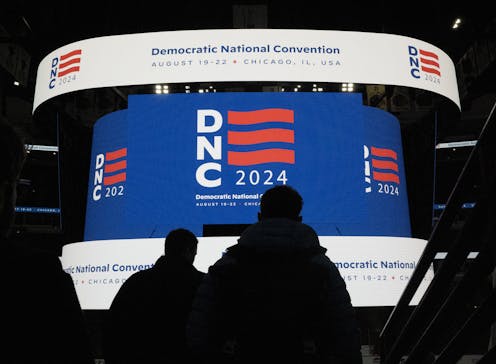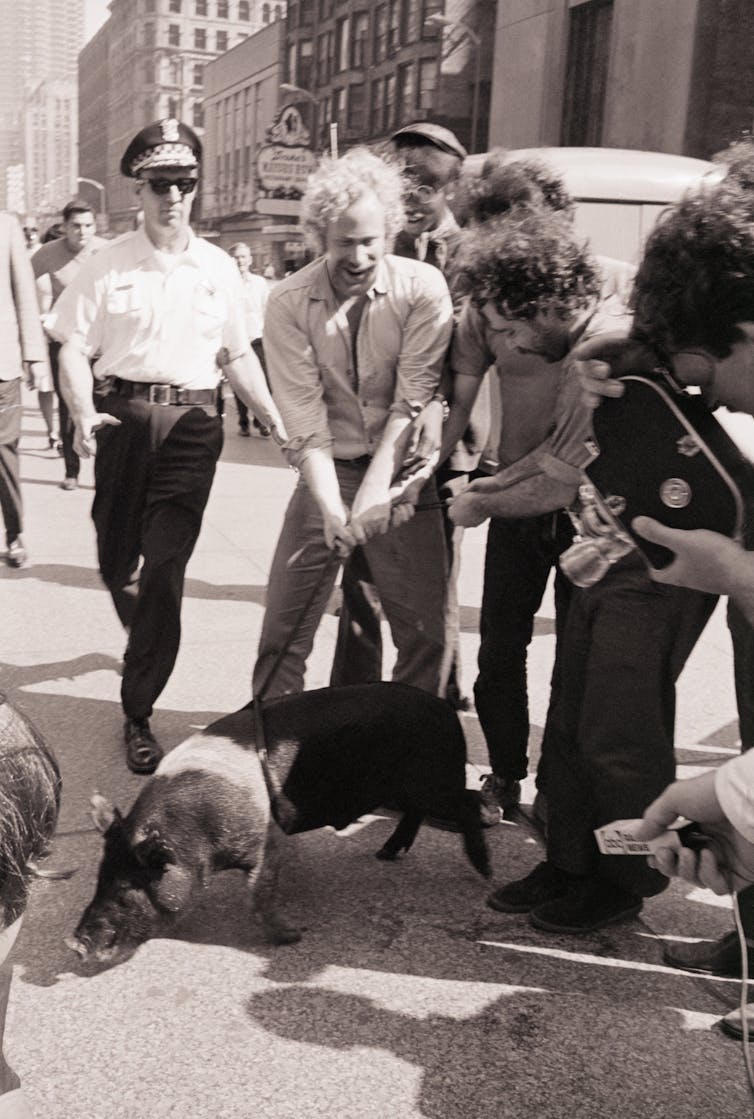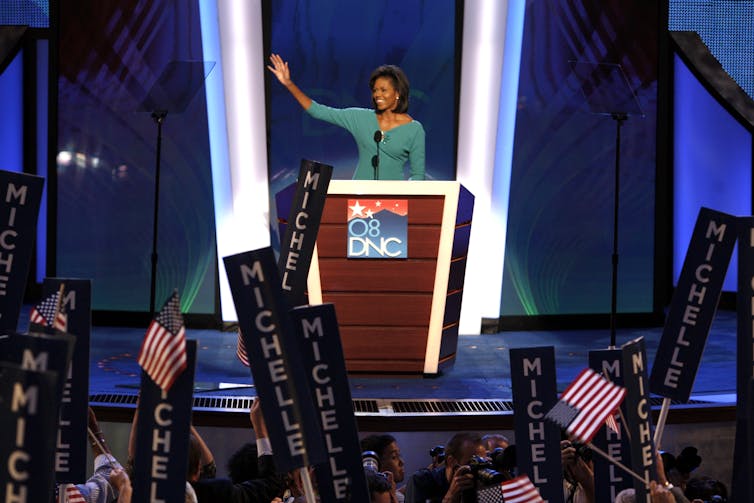From a pig as political candidate to a breakout speech for Obama − Democratic National Convention of
Kamala Harris and Tim Walz will officially accept their nominations at the Democratic National Convention. A scholar of the presidency shares memorable moments from previous events.

If the Yippies – a group of young activists known for political dissent – had their way, Americans would have elected a 145-pound pig named Pigasus as president in 1968.
The Yippies were famous for their unconventional tactics and were at the heart of the 1960s counterculture movement in the U.S. They demanded that Pigasus be treated as a legitimate candidate with Secret Service protection and foreign policy briefings.
Police arrested several Yippies for disorderly conduct after they paraded Pigasus outside the 1968 Democratic National Convention. Pigasus was taken into “protective custody” by police and eventually wound up at a farm.
Since the first Democratic National Convention in 1832, the event has had a long and storied history with headline-grabbing moments – some of which have left a mark in politics.
The Democratic Party will next converge at its convention in Chicago, Aug. 19-22, 2024. Vice President Kamala Harris and Minnesota Gov. Tim Walz will officially accept their party’s nomination as the Democratic candidates for president and vice president.
As a scholar of the presidency, I think it is useful to remember that national political conventions often function like pep rallies, leading up to the big game of the general presidential election. These conventions can be places where new faces are launched, or they can be so dull that the country is functionally put to sleep. Here are a few of the more memorable moments to emerge from a Democratic National Convention.

A first lady steps into the spotlight
In 1940, Eleanor Roosevelt became the first first lady to ever address the Democratic National Convention.
Democrats at the convention were divided over both the U.S.’s participation in World War II and the prospect of nominating Franklin Delano Roosevelt, or FDR, as he was known, to a third term. No president had served more than two terms at this point. It was about a decade before the 22nd Amendment was ratified and became part of the Constitution, restricting presidents to two terms in office.
FDR was trying to break a two-term presidency tradition that started with George Washington.
Eleanor Roosevelt got up in front of the contentious and squabbling convention and said, “This is no ordinary time. No time for weighing anything except what we can do best for the country as a whole, and that responsibility rests on each and every one of us as individuals.”
Eleanor Roosevelt’s influential speech helped reframe the first lady as a powerful advocate for the president, without being simply a mouthpiece for him. Her depiction of 1940 as “no ordinary time” helped people accept that the country was facing an extraordinary moment in history that needed consistent leadership.
Roosevelt won another two terms and went on to serve as president until his death in 1945 during his fourth term.

A fresh vision
Years later, when John F. Kennedy accepted the nomination at the Democratic National Convention in 1960, he said that voters needed to choose “between national greatness and national decline.” Kennedy’s speech, known as the “New Frontier,” helped show voters that a Kennedy presidency could overcome problems with a forward-looking vision.
“Today our concern must be with that future. For the world is changing. The old era is ending. The old ways will not do,” Kennedy said.
Kennedy also called for a new America that was not weighed down by nostalgia.
Texas politician Ann Richards also supercharged her career with a Democratic National Convention keynote address in 1988. Her speech, funny and sharp, was also a commentary on the growing role of women in politics – and what an achievement it represented.
In her opening words, Richards talked about Fred Astaire, one of the most famous Hollywood movie stars in the 1930s, as well as Ginger Rogers, his co-star and dance partner.
“Ginger Rogers did everything that Fred Astaire did. She just did it backwards and in high heels,” Richards said.
Richards skewered the perception that Astaire was the bigger star by pointing out Rogers was every bit as capable and talented – and even did it in uncomfortable shoes.
At the time, Richards was the treasurer of Texas. But her witty speech propelled her into the national spotlight and helped her become governor of Texas in 1991.
The introduction of hope
In 2004, Barack Obama, then a 43-year-old Illinois state senator, launched himself on the national scene with his speech at the Democratic National Convention.
Obama gave a passionate speech paying tribute to his background, stating, “I stand here knowing that my story is part of the larger American story, that I owe a debt to all of those who came before me, and that, in no other country on earth, is my story even possible.”
And he offered a self-deprecating observation, saying the country embodied “the hope of a skinny kid with a funny name who believes that America has a place for him, too. The audacity of hope!” These ideas of hope and unity later became key hallmarks of Obama’s 2008 presidential campaign.
Obama’s speech outshone the 2004 Democratic presidential candidate, John Kerry, and helped position him as the party’s rising star. News commentator Chris Matthews noted after Obama’s speech, “We’ve just seen the first black president.”

A political blunder
Some speeches are so memorable, they are even recycled.
Michelle Obama, the wife of then-Sen. Barack Obama, memorably stressed the importance of dignity and hard work in her speech at the 2008 Democratic National Convention – the convention at which her husband was formally nominated for president. Obama said that she and Barack were raised with the same values: “That you work hard for what you want in life; that your word is your bond and you do what you say you’re going to do; that you treat people with dignity and respect even if you don’t know them, and even if you don’t agree with them.”
Melania Trump heavily paraphrased this speech in her 2016 Republican National Committee speech. She, too, said that her parents raised her with values – “that you work hard for what you want in life, that your word is your bond and you do what you say and keep your promise, that you treat people with respect.”
Trump’s speechwriter, Meredith McIver, took responsibility for the blunder, since she thought the draft speech shared with her contained Melania’s words. But in reality, Trump had given her Obama’s speech as an idea for what she wanted incorporated in her own speech.
Potential for magic
I believe that national party conventions matter only for moments of mistake or magic. While these events are supposed to motivate voters and help reach out to the undecided, modern conventions more often are uninspired echo chambers of blather.
They do little to sway swing voters and only offer confirmation to voters already committed to their choice. Everyone in the audience is there to cheer and be energized by their home team.
Moments of greatness are far and few between at national conventions. But when lightning strikes, it can turn a phrase into an iconic moment that encapsulates an entire era.
Shannon Bow O'Brien does not work for, consult, own shares in or receive funding from any company or organization that would benefit from this article, and has disclosed no relevant affiliations beyond their academic appointment.
Read These Next
What’s at stake in Trump’s executive order aiming to curb state-level AI regulation
In the absence of comprehensive federal AI regulation, states have stepped in. The Trump administration,…
Whether Netflix or Paramount buys Warner Bros., entertainment oligopolies are back – bigger and mor
Hollywood has seen this movie before.
Donor-advised funds have more money than ever – and direct more of it to politically active charitie
When foundations make grants to DAFs, the digital trail normally created instead becomes a dead end.





